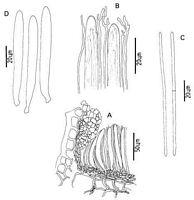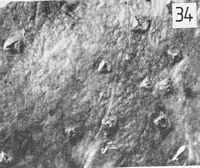|
 Marthamyces quadrifidus Marthamyces quadrifidus
SynonymsPropolis quadrifida
Stictis quadrifida
BiostatusPresent in region - Indigenous. Non endemic
Images (click to enlarge)
Caption: Fig. 20. Propolis quadrifida: A, ascocarp margin in cross-section. B, apices of asci and
paraphyses. C, released ascospores. D, asci. | 
Caption: Fig. 34 Macroscopic appearance of ascocarp (x 12). P. quadrifida. |
Article: Johnston, P.R. (1986). Rhytismataceae in New Zealand. 1. Some foliicolous species of Coccomyces de Notaris and Propolis (Fries) Corda. New Zealand Journal of Botany 24(1): 89-124 (http://www.rsnz.org/publish/abstracts.php).
Description: Ascocarps forming on upper and lower surfaces of Fallen leaves; not associated with a
differentiated lesion. Ascocarps round in outline, 0.3-0.5 mm diam. Ascocarps initially
having the appearance of small, raised pustules on host surface. Opening by several, irregular,
radiate splits, exposing the white, pruinose hymenium.
Ascocarps subepidermal. In vertical section the marginal tissue comprising a few layers of
hyaline, thin walled hyphae, and a poorly developed layer of periphyses. The periphyses
becoming intermixed with crystals, which form a broad, wedge-shaped layer near top of
margin. Subhymenium rests directly on disintegrating host tissue.
Paraphyses 1-2 µm diam., undifferentiated to slightly and irregularly swollen near the
apices, often with short side branches, intermixed with scattered crystals, not extending
beyond asci. Asci 72-101 x 6.5-9.5 µm, cylindric, apex broadly rounded to acute, uniformly
thin walled, non-amyloid, , 8-spored. Ascospores 53-72 x 1.8-2.5 µm, not tapering, 0-1
septate, gelatinous sheath present.
CHARACTERISTICS IN CULTURE: Ascospores of PDD 43971 and PDD 44691
germinated on agar plates. Colonies on oatmeal agar 2-3 cm after 12 weeks; aerial mycelium
white to slightly pink, cottony to felted; agar brownish near centre of colony. Remaining
sterile.
Habitat: Found on fallen leaves of a number of plants, including Agathis australis Salisb.,
Weinmannia racemosa, and Knightia excelsa. Sherwood (1977) reported this species as
common throughout tropical and subtropical America.
|